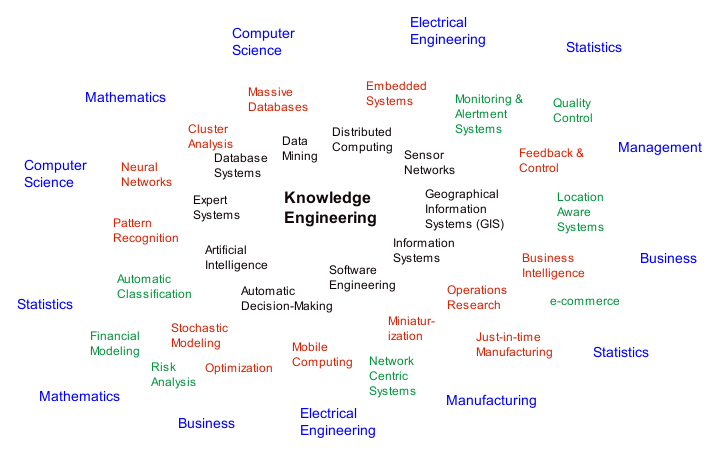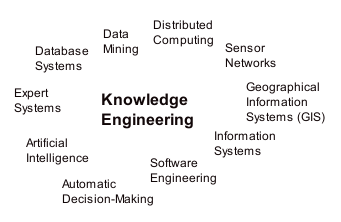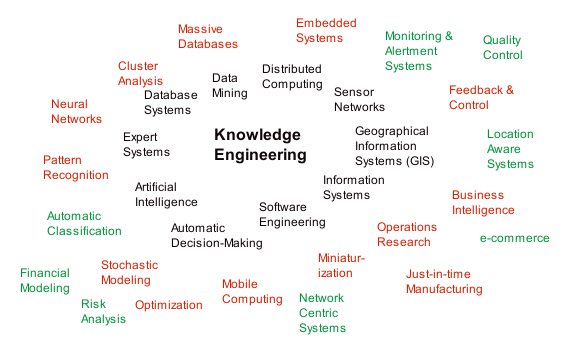2nd ed. Jan 2024 (with standalone chapters), 1st. ed. 2005
Overview
In the intersection between Mathematics, Modern Statistics, Machine Learning & Data Science, Electrical Engineering & Sensors, Computer Science, and Software Engineering, is a rapidly accelerating area of activity concerned with the real-time acquisition of rich data, its near real-time analysis and interpretation, and subsequent use in high quality decision-making with automatic adjustment and intelligent response. These advances are enabled by the development of small, energy efficient microprocessors coupled with low-cost off-the-shelf sensors, many with integrated wireless communication and geo-positional awareness, communicating with massive high-speed databases. For teams able to bridge the disciplines involved, the potential for economically productive application is limitless.

Traditional science and technology disciplines are in the outermost ring, often isolated from each other. The result of their integration is driving the areas out of which a large portion of technology in the coming decades is likely to appear.
This area can perhaps be called Knowledge Engineering, or the use of engineering methodologies to dramatically accelerate the rate at which knowledge is obtained, understood, distributed, and put to use.
The following figures illustrate the circle of disciplines whose techniques are contributing to Knowledge Engineering and its various applications.

Figure 1.
Figure 1. Those areas that most closely border the core area of Knowledge Engineering.

Figure 2.
Figure 2. Expanding outward, one intersects areas combining major science and technology disciplines.

Figure 3.
Figure 3. The full scope of the situation: traditional science and technology disciplines are in the outermost ring, often isolated from each other. The result of their integration is what is driving the areas out of which a large portion of technology in the coming decade is likely to appear.
“Where is the wisdom we have lost in knowledge? Where is the knowledge that we have lost in information?” T.S. Eliot , The Rock (1934)
With the emergence of AI Agents and models released to the public in 2023, the trends above are likely to accelerate. There are profound implications for education at all levels (primary, secondary, undergraduate, and post-graduate), and government/civil society efforts to ensure that access to this knowledge/capability does not become a a new element in the stratification of society between those who understand and can leverage knowledge engineering, and those at risk of getting increasingly left behind, with the attendant implications on social mobility and generational trends.
The following chapters provide some (partial) coverage of the topics above. Each is stand-alone, allowing a browse-by-interest approach. The material is primarily geared to those newly approaching the field and with an interest that exceeds their background. (I have used parts of this in intensive summer development programs for motivated high school / early undergraduate students.)
Part 1: Ubiquitous Computing
Chapter 1: Knowledge Engineering & Emerging Technologies: A View of what’s coming in the Next Decade (2005-2015)*
Chapter 2: The Advance of Sensor Networks and Autonomous Systems
Chapter 3: Sensors and Systems: Integrating Sensors into the Ubiquitous Computing Stack
Part 2: The Software Stack
Chapter 4: Software as a Force Multiplier (especially Sections 1-3)
Chapter 5: The sacred and the profane: low-level software engineering and the search for simplicity in the hardware-software combination
Chapter 6: Seven Fields of Computer Programming: A Brief Survey
Chapter 7a: Language-Oriented Programming: Forth, Lisp, and Ruby: Languages that enable solving your problem in a language appropriate for your domain (domain-specific language).
Chapter 7b: The Forth Language for (Embedded) Systems Programming
Chapter 8: Bare Bones Programming: The C Language for Embedded and Low-Level Systems Development
Chapter 9a: Demystifying the Assembly Language Toolchain
Chapter 9b: A low-level toolchain for x86: NASM (Netwide Assembler) and TCC (Tiny C Compiler)
Part 3: The Embedded Stack
Chapter 9: Microcontrollers, Sensors, and Embedded Systems: Low-Cost Experimenting with Arduino
Chapter 10: Voice Controlled Hardware and the Human-Sensor Interface
Chapter 11: Programming Low-Power, Low-Cost Microcontrollers – Atmel, Arduino, ATtiny – A Homebrew Toolchain including a 3-instruction Forth
Part 4: The Hardware Stack
Chapter 12: Rapid Prototyping Electronics: A Component Level View
Part 5: Statistical Computing (aka Machine Learning, Artificial Intelligence)
Chapter 13: Fuzzy Computing for Automatic Control
Appendix 1: Implications for Education
Chapter A: Electronics in the Junior School: Gateway to Technology
Chapter B: Coding for Pre-Schoolers: A Turtle Logo in Forth
Chapter C: Becoming an Army of One: Computing & Software as Force Multipliers
Chapter D: Teaching the Engineered Solutions Approach
Chapter E: Precise, Clear Communication in Industry – Cross-over Benefits from Mathematics and Logic
Chapter F: Benefits of Enriched Mathematics Instruction
Chapter G: Teaching Enriched Mathematics
Appendix 2: Advances in Emerging Technology
Breakthrough Science
Emerging Technology
Computing
Data Science & Applied Mathematics

Leave a Reply